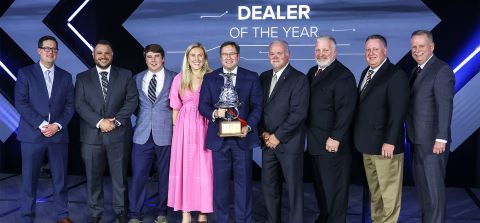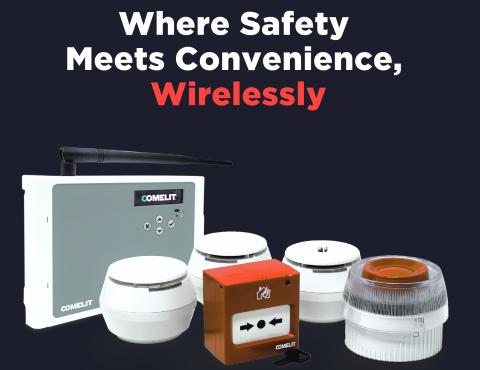With the new LUKAS e3 -series you will work more efficiently and safely from now on – thanks to a smart dashboard for better control. Smart. Safe. Efficient.
LUKAS Hydraulics is a market leading hydraulic rescue equipment provider, who consistently breaks boundaries and places innovation at the forefront of their business. Their hydraulic rescue equipment, not only aesthetically beautifully designed, but is also compact, lightweight, water submersible and battery operated for a seamless operation.
International Fire Buyer Editor catches up exclusively with Daniel Engelhardt, Product Manager LUKAS RESCUE, to find out all about their new e³ rescue equipment series, and how this new innovative equipment can benefit the industry. We also discover how the equipment is rigorously tested, and what is unique about this new series.
What sets LUKAS apart from competitors?
LUKAS was the first manufacturer of hydraulic rescue equipment in the world who managed to launch a battery-powered set consisting of a cutter, spreader, combi and ram in 2010.
At that time, we were confident enough to take this development step and since then it was our goal, including initial setbacks, to convince customers of the superiority of battery technology.
Thanks to this clear strategy, we have succeeded in convincing the global market of the superiority of battery-powered equipment, so that in recent years we have seen a large proportion of customers switch from conventional technology to battery technology.
We have maintained this focus on battery technology over all these years and try to offer our customers a clear added value with each new generation of equipment and were thus able to defend our place at the top as the leading supplier of battery-powered rescue equipment.
LUKAS founded the first hydraulic cutter; how do you maintain innovation in the marketplace?
Most important, of course, are the insights we receive from the market. Through our sales team and our dealers, who are active in over 100 countries worldwide, we receive a lot of feedback on our current tools, which we then incorporate into the development of new generations of tools.
In addition, we at LUKAS have flat hierarchies and short working channels. The cooperation between sales, product management, R&D and supply chain work extremely well, so that very little time passes from the introduction of the idea to its implementation.
In addition, we have often been right with our trend forecasts in recent times. Battery technology is one example of how we recognized a trend very early on, and the saltwater resistance of our battery-powered devices is another.
When we launched this on the market in 2019, many people perceived it as a superfluous feature. However, we were also able to see from the incredibly sad example of Germany this year that such terrible natural disasters caused by climate change will significantly increase in number and intensity in the coming years. We are also being asked about this topic much more frequently by customers around the world and are pleased to have recognised this trend very early.
You recently released the e3 rescue equipment series, what makes these tools unique?
‘POWER under e³ CONTROL’. This is the claim of our new e³ Battery series.
This claim is extremely appropriate, because it stands for everything that was important to us in the development of the tools.
On the one hand, our e³ tools offer the POWER that our customers are already used to from our previous battery generations. On the other hand, our e³ tools are the first tools in the world that give the user direct feedback while working.
They offer the user a level of CONTROL that has never been seen before in rescue equipment. We have achieved this through our DASHBOARD, which is mounted in the user’s field of vision and provides performance diagnostic information to the user during operation. The customer is informed at all times about how much remaining capacity the battery has, what power reserves the tool still has, whether the turbo is active or inactive, and in which direction the star grip is turned. This is made visible on the DASHBOARD by illuminated LEDs, which alert the customer to the situation of the tool by means of a visual signal in case of application.
We are particularly proud of our newly developed roll warning. The lateral twisting of the shear in use beyond a limit point can cause the material being cut to press between the blades. Also, wrong or the unfavorable shape of the material to be material to be cut can also lead to the same result. This can lead to increased lateral force, overlap or, in rare cases, even breakage of the blades. If the cutter is twisted during the cutting process, which could blade breakage, the LED ring on the dashboard flashes LED ring on the dashboard flashes red and warning the user not to continue the cutting process. The user is alerted of any false start and an imminent situation and can take corrective action.
Our tools are also the only ones in the world that are also used in salt water. For this purpose, we have developed a new saltwater battery that allows our tools to be used in 3m deep salt water for up to 60 minutes.
With this world first, we have opened up another field of application and can now offer our customers a holistic solution that did not exist before. Our e³ tools are powered by our proven 5Ah and 9Ah batteries, the latter of which is the most powerful battery with the longest runtime of any rescue tool on the market.
The e3 range has an intelligent turbo function, could you explain what this means and how it benefits users?
All e³ rescue tools have our new turbo function. This is activated as soon as the star grip control is turned over a defined activation point in the opening or closing direction. What makes the turbo unique on the market is its intelligent mode of operation. As soon as the blades of the cutter, the spreader arms, the combination blades or the claw of the ram hit very hard material, the tools reduce the working speed to a level optimized for the user and continue working at normal speed. The automated speed adjustment provides a much higher level of SAFETY and CONTROL, exactly when it is needed. The tool relieves the user of the need to adjust and reduce speed, especially when cutting very hard materials, thus preventing a potentially dangerous situation. An uncontrolled movement of the tool, a twisting of the blades or a slipping of the spreader can be detected, corrected, or stopped much easier at normal speed than when working at continuous turbo speed. Our e³ tools continue to work with the same POWER, but the user retains CONTROL over the tool at all times, as the speed adapts to the conditions at hand.
What are the advantages of battery power?
There are some advantages that battery technology brings compared to conventional technology. For one thing, there is the noise level. In contrast to the high noise level generated by a conventional hydraulic unit with a gasoline engine, battery-powered devices only generate noise when they are actively working. Another important aspect is the high level of safety due to the lack of hoses. Hoses lying around are often trip hazards, especially when the scene is unclear or when working at night.
The time factor is also a plus point for battery-powered devices. Instead of awkward coupling, only the battery has to be inserted and the tools are ready for use. With the introduction of our new e³ generation of equipment, rescue equipment is now ready for use in truly any environment imaginable.
Due to the elimination of hoses and the hydraulic power unit and the associated ease of transpotability, battery-powered devices are particularly advantageous when working in very confined spaces, in very steep and difficult-to-access terrain. With our e³ it is now also possible to work with the tools in salt water. This was actually the last hurdle of limitation, which we have now successfully mastered. As a result, we are hoping for a significant increase in market share in the area of USAR operations.
There are several more points in favour of battery technology, and the fact that these appeal to customers can be seen in the fact that the entire market for hydraulic rescue equipment has changed to a battery market in very few years.
When testing your products, do you simulate a rescue and put the tools through their paces?
What sets our tools apart is their superior performance in the field. Of course, we also pay attention to weight and design in the development process, but user-friendliness and operability are always at the forefront of our developments.
For this, the tools are extensively tested for functionality on simulated rescue scenarios during the development phase by the R&D team in cooperation with the sales team.
In series production, we then have 100% testing of each individual rescue device before delivery. This is done on special test stations, of course there is also a test protocol for each rescue device, which is signed by the respective tester to be able to guarantee one hundred percent traceability and quality.
What would your top tips be for customers using your equipment?
General tips for the use of our tools are difficult to define. We realise that each country has different rescue techniques, which are trained by the respective technical rescue experts in the country.
Regarding the purchase of new rescue equipment, we can give the tip that customers should pay attention to buy rescue equipment with sufficient power reserves. If I purchase rescue equipment today, it should have sufficient power reserves so that it will still be able to cope with technical rescue tasks in a few years’ time. We ourselves have the opportunity to test new vehicles again and again and have noticed that the materials used in new vehicles are many times harder than was the case a few years ago. That is why we always explain to our customers during demonstrations that the vehicles they cut in our exercises, which usually come from the scrap yard, do not reflect the conditions on the roads, where the proportion of new vehicles is naturally much higher.
To stay up to date on the latest, trends, innovations, people news and company updates within the global fire market please register to receive our newsletter here.
Media contact
Rebecca Morpeth Spayne,
Editor, International Fire Buyer
Tel: +44 (0) 1622 823 922
Email: editor@firebuyer.com









